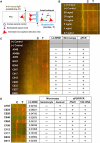A saliva-based rapid test to quantify the infectious subclinical malaria parasite reservoir
- PMID: 30602535
- PMCID: PMC6441545
- DOI: 10.1126/scitranslmed.aan4479
A saliva-based rapid test to quantify the infectious subclinical malaria parasite reservoir
Abstract
A large proportion of ongoing malaria parasite transmission is attributed to low-density subclinical infections not readily detected by available rapid diagnostic tests (RDTs) or microscopy. Plasmodium falciparum gametocyte carriage is subclinical, but gametocytemic individuals comprise the parasite reservoir that leads to infection of mosquitoes and local transmission. Effective detection and quantification of these carriers can help advance malaria elimination strategies. However, no point-of-need (PON) RDTs for gametocyte detection exist, much less one that can perform noninvasive sampling of saliva outside a clinical setting. Here, we report on the discovery of 35 parasite markers from which we selected a single candidate for use in a PON RDT. We performed a cross-sectional, multi-omics study of saliva from 364 children with subclinical infection in Cameroon and Zambia and produced a prototype saliva-based PON lateral flow immunoassay test for P. falciparum gametocyte carriers. The test is capable of identifying submicroscopic carriage in both clinical and nonclinical settings and is compatible with archived saliva samples.
Copyright © 2019 The Authors, some rights reserved; exclusive licensee American Association for the Advancement of Science. No claim to original U.S. Government Works.
Conflict of interest statement
R.R.D., D.T., and B.M. are inventors on patent/patent application (PCT/US2016/037968) held/submitted by Johns Hopkins University that covers the described saliva-based malaria rapid test. The technology is licensed to Erada Technology Alliance Limited, Mauritius. D.J.S. receives royalties from Alere for provision of positive control antigens for the Binax malaria RDT and is a named inventor and consultant for Fyodor Biotechnologies who licensed a urine malaria test from Johns Hopkins University. P.D.S. and C.C.S. are with Oasis Diagnostics, a manufacturer of RDTs using saliva. No other competing interests have been identified.
Figures




Comment in
-
The Longest Mile: Moving Malaria from Clinical Care to Elimination of Transmission.Clin Chem. 2019 Aug;65(8):946-948. doi: 10.1373/clinchem.2019.303719. Epub 2019 Jun 6. Clin Chem. 2019. PMID: 31171527 Free PMC article. No abstract available.
-
Translational Proteomics: Driving Biomarker Discovery in the Clinical Laboratory.Clin Chem. 2019 Jun 1;65(6):817-818. doi: 10.1373/clinchem.2019.304642. Clin Chem. 2019. PMID: 32100847 No abstract available.
References
-
- World Health Organization , World Malaria Report (World Health Organization, 2017).
-
- Bottius E., BenMohamed L., Brahimi K., Gras H., Lepers J. P., Raharimalala L., Aikawa M., Meis J., Slierendregt B., Tartar A., Thomas A., Druilhe P., A novel Plasmodium falciparum sporozoite and liver stage antigen (SALSA) defines major B, T helper, and CTL epitopes. J. Immunol. 156, 2874–2884 (1996). - PubMed
-
- Bousema T., Okell L., Felger I., Drakeley C., Asymptomatic malaria infections: Detectability, transmissibility and public health relevance. Nat. Rev. Microbiol. 12, 833–840 (2014). - PubMed
Publication types
MeSH terms
Substances
Grants and funding
LinkOut - more resources
Full Text Sources
Medical
Miscellaneous

